-Tate-Photography.jpg)
Edson Chagas, Tipo Passe, 2014, installation view, A World In Common: Contemporary African Photography, Tate Modern, 2023. © Tate Photography, Lucy Green. Courtesy of the artist and Apalazzo Gallery.
Tate Modern, London
6 July 2023 – 14 January 2024
by DAVID TRIGG
The vastness of Africa’s geography, not to mention its demographic, cultural, religious and linguistic diversity, means that attempts to define a singular notion of the continent will inevitably be found wanting. Similarly, any exhibition seeking to survey the photographic output of its 54 sovereign countries is setting itself up for failure. A World in Common: Contemporary African Photography takes a more sensible approach, focusing on 36 artists whose work responds to Africa’s diverse cultural traditions, the history of modern colonialism and present-day social, political and environmental concerns. Drawing on the ideas of the Cameroonian philosopher Achille Mbembe, the show considers the global implications of decolonisation while inviting us to imagine “a world in common”, that is, an acknowledgement of the world’s interconnectedness and the importance of the African continent in its past, present and future.
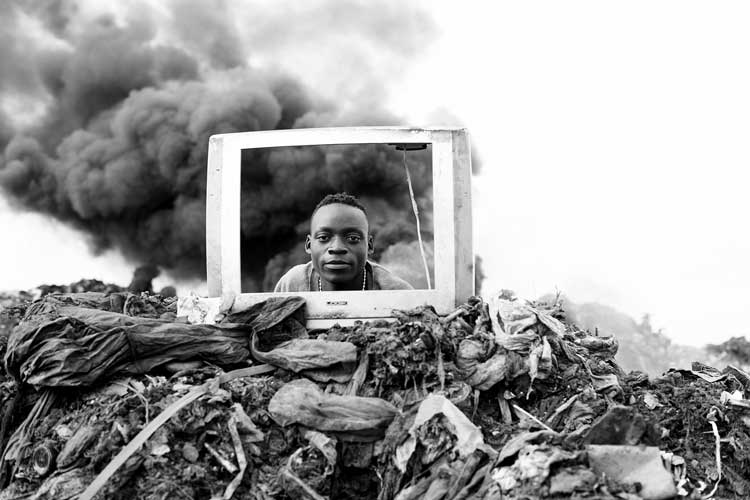
Mario Macilau, Breaking News from The Profit Corner series, 2015. Archival pigment print on cotton rag paper. © Mário Macilau, Courtesy Ed Cross Fine Art.
The Berlin Conference of 1884-85 established the legal framework for the European partition of Africa; the apex of centuries of theft, expropriation and colonial subjugation on the continent by European powers. Despite this, regional kingdoms remain important in many African societies, demonstrating the role of ancestral legacies and traditions in shaping African identities. George Osodi spent a decade photographing the rulers of these modern-day monarchies across Nigeria. His Nigerian Monarchs series (2012-22) opens the exhibition with an assortment of elegant kings respectfully pictured in full regalia. HM Ogiame Atuwatse III looks serene on his ornate gold throne, while the elaborately decorated robes of the long-reigning HRM Agbogidi Obi James Ikechukwu Anyasi II evoke Nigeria’s colonial past with a prominent image of Queen Elizabeth II.
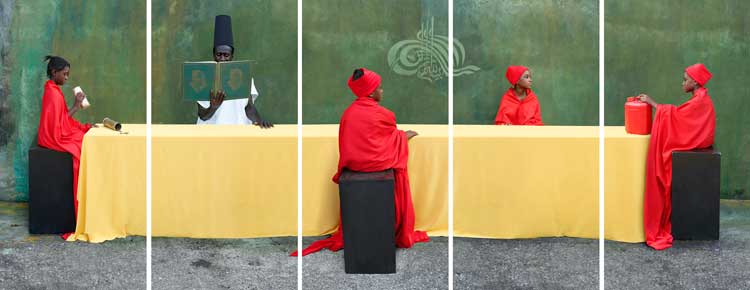
Maïmouna Guerresi, M-eating – students and teacher, 2012. Five photographs, colour, lambda print, on paper mounted on aluminium, 150 × 388 cm. Courtesy of the artist and Mariane Ibrahim.
A section addressing the complex nature of spirituality in Africa contains works that reflect the various sacred myths and beliefs that have been passed down the generations. Among those drawing from indigenous African, Christian and Islamic iconographies is the five-panel tableau M-eating – Students and Teacher (2012) by the Senegalese artist Maïmouna Guerresi. A religious leader in a tall black hat reads the Sufi scriptures to four girls wearing bright red clothing as they sit around a long dinner table. Instead of food, there are objects suggestive of war – a petrol can and a shell casing – which seem almost ornamental in this striking meditation on the nature of spiritual sustenance in the face of strife and upheaval.
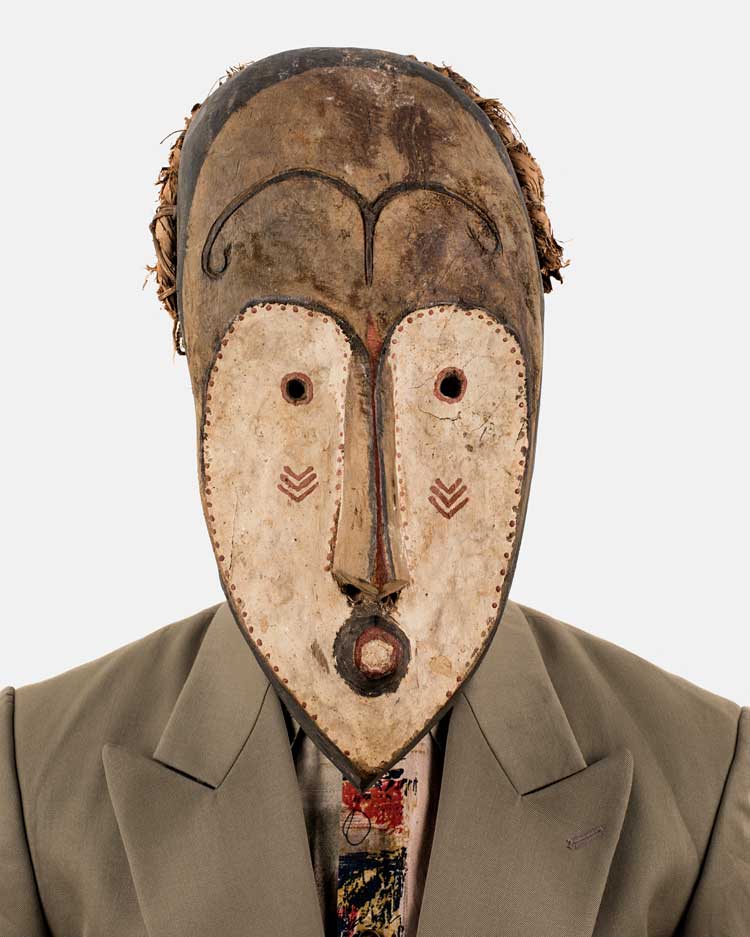
Edson Chagas, Tipo Passe, Pablo P. Mbela, 2014. C-print on matte Kodak photo paper; 10 x 8 cm. Courtesy the artist and Apalazzo Gallery.
Masks are integral to rituals and ceremonies across Africa. The Angolan photographer Edson Chagas’s Tipo Passe (2014) comprises a series of striking portraits depicting sitters dressed in contemporary clothing, their faces covered by large traditional Bantu masks, which are highly prized by western collectors. In a world where objects are frequently valued above people, Chagas’s passport-style photographs confront us with the question of why such artefacts are more welcome abroad than those who make and use them.
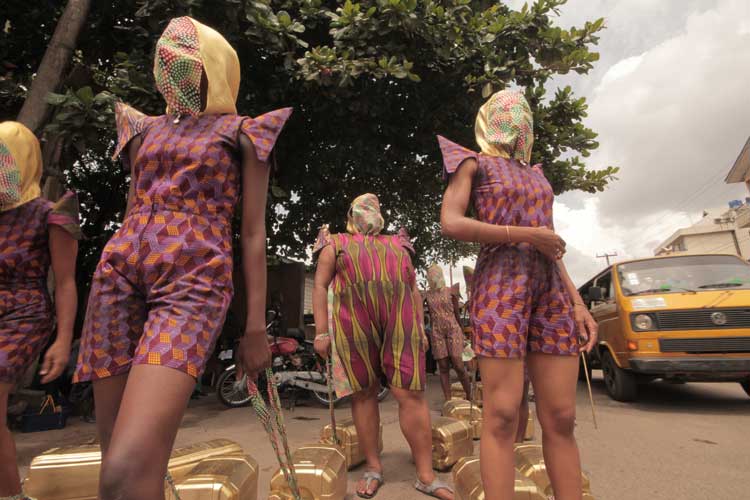
Wura-Natasha Ogunji, Will I still carry water when I am a dead woman, 2013. Single-channel digital video, 11 min, 57 sec. Fridman Gallery © Wura-Natasha Ogunji. Photo: Ema Edosio.
More face coverings feature in Wura-Natasha Ogunji’s video Will I Still Carry Water When I Am a Dead Woman? (2013), a street performance that sees a procession of masked women dragging heavy kegs of water through the dusty streets of Lagos. These faceless labourers represent the drudgery faced by so many women who struggle to meet even their basic daily needs. Might another way of existing be possible? Ogunji’s powerful film leaves the question open-ended.
Memory emerges as an important theme in the work of several artists, including Sammy Baloji, whose haunting Mémoire series (2006) combines colour photographs of dilapidated mineral mines in the Democratic Republic of the Congo with colonial-era images of the downtrodden and shackled labourers who worked at the once-prosperous sites. Baloji’s photomontages highlight the changing economic fortunes of the Katanga region which, after suffering significant industrial decline in the post-independence period, is now meeting the demand for cheap cobalt, a mineral essential to the rechargeable batteries that power phones, laptops and electric vehicles, and which Congolese workers, including children, extract from the ground largely by hand.
The relationship between memory and photography is explored by the Angolan artist Délio Jasse, whose The Lost Chapter: Nampula, 1963 (2016) features 12 found black-and-white photographs depicting an anonymous Portuguese family living in Mozambique, which Jasse has superimposed with screenprinted passport stamps and government documents. The installation foregrounds the role of the artist as researcher and archivist while highlighting the economic disparity between Portuguese colonialists and Mozambicans in the 1960s. Your eye scans the images, looking for signs of Mozambique, but the scenes could almost be anywhere – a poignant reminder of colonial erasure.
The rich tradition of studio portraiture in West Africa gave its communities the opportunity to challenge the colonial gaze of ethnographic photography by controlling the medium for themselves. During the period of independence, figures such as Malick Sidibé in Mali and James Barnor in Ghana opened their own photographic studios, which became spaces for the joyful projection of new identities. A selection of black-and-white portraits from Barnor’s Ever Young studio capture the optimistic mood of a nation on the brink of freedom. A heartwarming group of smiling female nurses snapped in 1957 is echoed by Ruth Ginika Ossai’s colour portrait of green-uniformed students in present day Nigeria, one of several large-scale photographs in which family and friends pose in front of cinematic backdrops. The lively photoshoots are installed in a space evoking Ossai’s studio, complete with patterned laminate flooring.
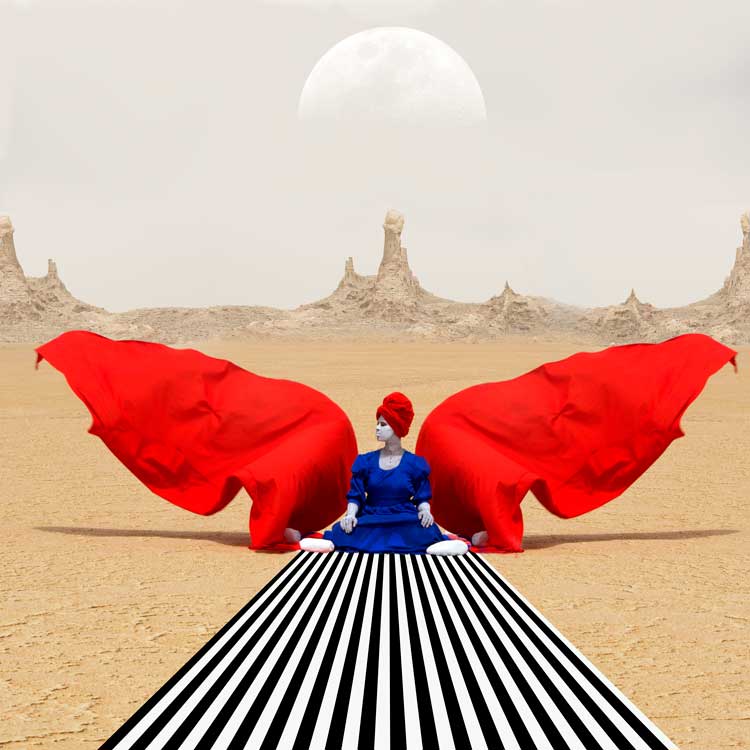
Aïda Muluneh, Star Shine Moon Glow, 2018. From the series Water Life. Photograph, inkjet print on paper, 80 x 80 cm. Commissioned by WaterAid and supported by the H&M Foundation. © Aïda Muluneh.
It is hard not to be wowed by the sheer diversity of creative approaches to photography in this exhibition. Some of the most striking are found in the final section, where environmental issues and the effects of globalisation come to the fore. Giant supernatural creatures rise up from smoking rubbish dumps, discarded fishing nets and burning landscapes in three photographs from Fabrice Monteiro’s The Prophecy series (2013-15). Their fantastical costumes, fashioned from waste materials, evoke the environmental damage caused by plastic pollution. Even more eye-catching is the set of four surreal images from Aïda Muluneh’s Water Life series (2018), which address rural water access in Ethiopia and its impact on women’s rights, wellbeing and education. Shot in the remote and arid salt flats of the Afar region, the highly staged tableaux feature women with painted bodies, symbolic props and vivid costumes with saturated reds and blues.
-Tate-Photography,-Lucy-Green.jpg)
Kiluanji Kia Henda, The Fortress, 2014, installation view, A World In Common: Contemporary African Photography, Tate Modern, 2023. © Tate Photography, Lucy Green.
Muluneh, who inaugurated the biannual Addis Foto Fest (the first and only photography festival in East Africa), is one of several big names in African photography to be included here. But there are others whose absence is notable: the Cameroonian-born Nigerian artist Samuel Fosso, who won this year’s Deutsche Börse Photography Foundation Prize with his inventive self-portraits; South African photographer Jo Ractliffe, known for documenting sites of violence and conflict in postcolonial Africa; and Zanele Muholi, the South African activist and acclaimed photographer who will be enjoying a solo exhibition at Tate Modern next year. It is also surprising to find several works that, even in the “expanded field”, could hardly be classed as photography – Kiluanji Kia Henda’s architectural sculpture The Fortress (2014) is an especially incongruous example, as is Ndidi Dike’s sprawling installation, A History of a City in a Box (2019), which fills the floor of another gallery with hundreds of old box files to conjure a vast cityscape.
-Tate-Photography,-Lucy-Green.jpg)
Ndidi Dike, A History of a City in a Box, 2019, installation view, A World In Common: Contemporary African Photography, Tate Modern, 2023. © Tate Photography, Lucy Green.
Africa is often unfairly stereotyped as a place riddled with poverty, corruption and despair and A World in Common doesn’t shy away from the harsh realities faced by many living on the continent. But there are also moments of joy and hope to be found here as artists imagine a more optimistic future, one unbound from the horrors of colonialism and the influence of outsiders. As the Senegalese academic Felwine Sarr puts it: “If you are not satisfied with our present, then you can begin to create a utopia, and then start to transform it into reality in the course of history. [I]t is the task of Africans to think and formulate their own future and to find their own metaphors for it … to dream this utopia in Africa itself, to design Africa ourselves, to think, and to act for ourselves.”1
Reference
1. Afrotopia by Felwine Sarr.